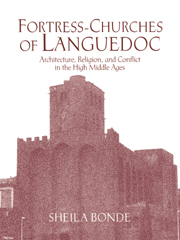Book contents
- Frontmatter
- Contents
- List of illustrations
- Acknowledgments
- Introduction
- 1 Ecclesiastical Fortification in the Middle Ages
- 2 The Larger Context: Languedoc in the Twelfth Century
- 3 The Buildings and the Documents: Maguelone, Agde, and Saint-Pons-de-Thomières
- 4 The Manning and Operation of Fortress-Churches
- 5 The Architectural Context: Sources and Parallels
- Conclusion
- Appendixes
- Tables
- Abbreviations
- Notes
- Bibliography
- Illustration credits
- Index
5 - The Architectural Context: Sources and Parallels
Published online by Cambridge University Press: 02 November 2009
- Frontmatter
- Contents
- List of illustrations
- Acknowledgments
- Introduction
- 1 Ecclesiastical Fortification in the Middle Ages
- 2 The Larger Context: Languedoc in the Twelfth Century
- 3 The Buildings and the Documents: Maguelone, Agde, and Saint-Pons-de-Thomières
- 4 The Manning and Operation of Fortress-Churches
- 5 The Architectural Context: Sources and Parallels
- Conclusion
- Appendixes
- Tables
- Abbreviations
- Notes
- Bibliography
- Illustration credits
- Index
Summary
In contrast to the aisled plans, multistoried elevations, and ribbed vaults of early Gothic architecture in the north of France, church design in Languedoc in the second half of the twelfth century tended to favor wide and aisleless two-storied basilicas with flat expanses of uninterrupted wall. The interior of Saint-Pons-de-Thomières, for example, is a large, unified volume nearly 15 meters wide (see Fig. 51). The surface of the walls encasing the interior space is interrupted only sparingly. Each bay is defined by the linear organization of vertical pilasters that carry transverse arches. Within each bay, small nave windows signal an otherwise undifferentiated second story. Round-headed windows originally opened into the nave to mark the presence of the lower gallery level, but the skeletal support of the building is otherwise unarticulated. The slightly pointed barrel vault, like the nave walls, features large flat areas of undecorated surface masonry.
Wide spans and planar surfaces seem to have been a feature of architecture in the Midi as early as the ninth century. These elements continued to dominate southern Gothic architecture of the mid-twelfth and thirteenth centuries. In this sense, the division between Romanesque and Gothic is less clearly defined in southern French architecture, or perhaps it is better to observe that the terms “Romanesque” and “Gothic” are less useful in describing the architectural history of Languedoc.
- Type
- Chapter
- Information
- Fortress-Churches of LanguedocArchitecture, Religion and Conflict in the High Middle Ages, pp. 128 - 172Publisher: Cambridge University PressPrint publication year: 1994



